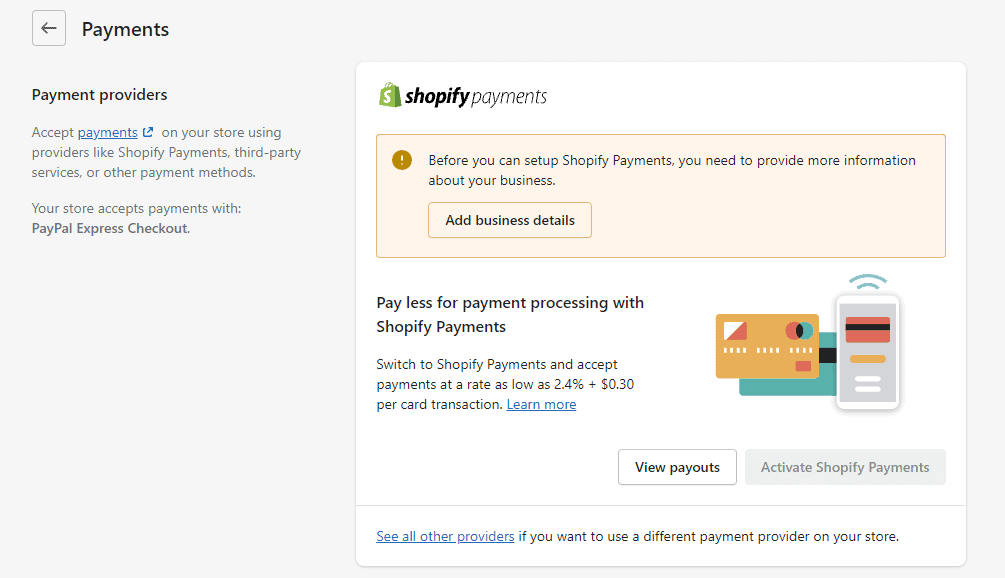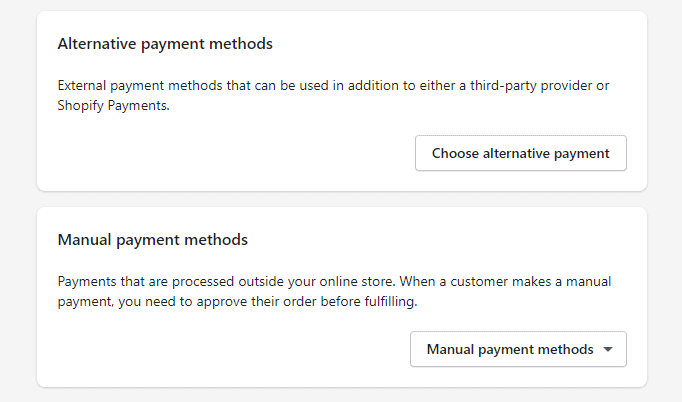How To Create Paypal Business Account For Shopify
Shopify's built-in payment processing feature allows you to accept credit card payments, and could be a money-saving addition to your Shopify store.
Advertiser Disclosure: Our unbiased reviews and content are supported in part by affiliate partnerships, and we adhere to strict guidelines to preserve editorial integrity.

Shopify is a popular commerce platform that offers a wide variety of sales tools and services to businesses. The Shopify ecosystem is absolutely gigantic, potentially serving as a one-stop shop for online stores, POS hardware, inventory management, staff management, and more.
For this post, however, we're going to zoom in on one important part of Shopify's infrastructure. Welcome to our deep dive into Shopify Payments.
What Is Shopify Payments?
Shopify Payments is Shopify's built-in payment processing feature, which allows you to accept credit and debit cards, as well as additional payment methods. By default, Shopify Payments is a white label version of Stripe and has most of that payment processor's strengths and weaknesses.
Merchants using Shopify aren't required to use Shopify Payments as their processor. It's possible to plug a different service into the app, but this can come with some added costs and inconveniences.
How Much Does Shopify Payments Cost?
How much Shopify Payments will cost you will depend on a number of factors. The good news is that Shopify waives the typical 0.5%-2% commission charge should you use Shopify Payments to process your transactions. Shopify Payments charges a flat rate for all transactions.
Here's where it gets a little confusing. While there's no monthly fee specifically for Shopify Payments, your Shopify plan will affect the amount you're paying for transactions.
- Shopify Lite
- Online: 2.9% + $0.30
- In-person: 2.7%
- Shopify Basic
- Online: 2.9% + $0.30
- In-person: 2.7%
- Shopify
- Online: 2.6% + $0.30
- In-person: 2.5%
- Shopify Advanced
- Online: 2.4% + $0.30
- In-person: 2.4%
For a rundown on how Shopify Payments stacks up to the competition, check out our complete Shopify Payments review. And for a deeper look at costs, click through to The Complete Shopify Fees & Pricing Guide.
Shopify Payments Available Countries
Access to Shopify Payments is geographically limited. To use Shopify Payments, your business must be located in one of the following countries:
- Australia
- Austria
- Belgium
- Canada
- Denmark
- Germany
- Hong Kong SAR
- Ireland
- Italy
- Japan
- Netherlands
- New Zealand
- Singapore
- Spain
- Sweden
- United Kingdom
- United States (Puerto Rico is the only supported U.S. territory)
Can You Still Use Shopify If You Don't Live In One Of These Countries?
While Shopify Payments is only supported in the countries above, Shopify the commerce platform is available in additional countries. Businesses located outside the Shopify Payments zone can still process payments within the Shopify app; however, they'll need to use an approved third-party payment gateway.
Remember that Shopify charges an additional transaction fee between 0.5 – 2% if you use a payment processor other than Shopify Payments with the platform.
How To Set Up Shopify Payments
If your business is eligible for Shopify Payments, there are a few steps to getting your account set up and ready to go. For the purposes of this guide, we're assuming that you already have a Shopify account and store set up and ready to go.
Note: you may be asked to verify your identity at various points when you're using Shopify Payments. While this is happening, your payouts may be on hold, but your store and ability to process payments should remain active during that time.
Step 1: Make Sure You're Eligible
As we covered above, Shopify Payments is only available in some of the countries in which the Shopify commerce platform is available. If you fall outside of that umbrella, you won't be able to use Shopify Payments. Banking requirements differ somewhat between countries, but generally you'll need to have an account with a bank that's physically located within the country in question.
You'll also need to make sure your industry and the products you're selling don't fall within the prohibited businesses list. These vary slightly between countries, so make sure you know what local policies apply to you. We'll talk a bit more about prohibited items and industries later in this post.
Step 2a: Complete Your Account Setup

Before you can take payments, you need to make sure Shopify has all the necessary information. While a fairly simple step, it's also likely to be the most time-consuming. Go to Settings > Payments.
If you haven't already added them, you'll be prompted to Add business details. You'll need to enter your EIN (or other applicable identifier) and select your business type. You may also be asked to fill out the Personal Details section depending on your type of business. Provide any requested documentation and you should be ready to move on.
Step 2b: Activate Shopify Payments
If you've already enabled a payment processor, you can switch to Shopify Payments by clicking on Activate Shopify Payments. This will switch your payment processor over to Shopify Payments. Your current payment processor will be removed from your account. You'll find the option under Settings > Payments.
Step 3: Configure Shopify Payments
Shopify Payments has a number of settings you can adjust right from within Shopify. You can reach most of these under Shopify Payments > Manage.
Here you can configure things like:
- Payment Notifications:Decide when and if you're notified by email when you receive a payout to your bank account.
- Fraud Prevention Tools:You can make things a little bit harder for fraudsters by enabling the address verification system (AVS) and/or the card verification value (CVV) feature. These solicit additional information from your customers before they can complete their credit card transaction. We'd generally recommend you turn these on, although they only work if customer's card-issuing bank supports them.
- Your Bank Account:You can keep your bank information updated here.
- Customer Billing Information:You can tweak the information that will be on the customer's credit card bill. You'll need to include your phone number.
- Tax Info:You entered this during an earlier step, but you can adjust your info here if there are any changes. You'll also resolve any additional tax requirements your government has here.
Step 4: Test Shopify Payments (Optional)
Once you've completed the previous steps, you may want to try a couple of test transactions to make sure everything is working correctly. You can enable test mode from Settings > Payments and then go to Manage within the Shopify Payments block.
While in test mode, you won't be able to process real credit card transactions. Shopify provides a number of fake credit numbers you can use to test successful, declined, and disputed transactions. When you're satisfied that everything is working correctly, turn test mode off and save your settings.
Step 5: Enable POS App (Optional)
Shopify is generally associated with eCommerce, but Shopify POS allows businesses to make sales in person, and scan credit cards with a Shopify card reader.
Download the Shopify POS app. Tap the burger to bring up a menu. Go toSettings > Payment settings.In theDefault Payment Typessection the credit/debit card option should read "Accepted."
Choosing Your Shopify Payment Methods
If you're using Shopify Payments as your default payment processor, it's still possible to add additional payment methods to your configuration. These external payment methods do not replace Shopify Payments, but allow for some additional ways for your customers to pay for your products. This doesn't require any additional fees upfront. You also will only pay the transaction fees for the gateway the transaction used, so you can rest assured that you won't be double-billed.
Shopify makes the process fairly straightforward. Popular payment methods like PayPal and Amazon Payments get their own interface (which we'll cover below). You can find other major payment methods–Alipay for example–under the Alternative payment methods block. Just follow the instructions for the selected payment method. Transaction fees will vary by payment method.
Manual payment methods are methods not covered by any other category. These include cash-on-delivery, money orders, and bank transfers. There's no transaction fee for a manual payment method. Instead, the order is marked unpaid until you manually mark it as paid.

Setting Up PayPal Payments In Shopify
PayPal is well-integrated with Shopify. In fact, when you set up your Shopify store, Shopify will create a PayPal Express Checkout account using that account.
You can manage your PayPal permissions throughSettings > Payments and going to the PayPal block. By deactivating the default PayPal account, you can select your PayPal account type and activate that one in its place. Certain configurations, like allowing customers to pay with a Guest account, will have to be done through your PayPal account rather than Shopify.
PayPal Checkout's default transaction fee is3.49% + $0.49.For a full breakdown of PayPal fees, check out How Much Does PayPal Charge? The Complete Guide To PayPal Credit Card Processing Fees.
Setting Up Amazon Payments In Shopify
If your account is geographically eligible for Amazon Pay, you'll find an interface for it underSettings > Payments.For the unfamiliar, Amazon Pay allows online shoppers to make purchase's on a merchant's website using their Amazon account.
On the Amazon Pay interface within your Shopify account, clickActivate Amazon Pay.You'll sign in with your existing Amazon Pay account or go through the process of creating a new one. At the end of the process, click Transfer Credentials to Shopify.
Amazon Pay transactions are comparable to Shopify Payments, defaulting to2.9% + $0.30.
Setting Up Shop Pay
Shop Pay is Shopify's accelerated checkout feature. Customers who have enabled Shop Pay can store their payment information for future use at any Shopify store.
As you might expect, Shop Pay plays very nicely with Shopify Payments, so setting it up is a breeze. Go to Settings > Payments and to the Shopify Payments block. ClickManage. Find theShop Pay section and simply enable Shop Pay. Save your settings and you're ready to go.
There are no additional fees for Shop Pay beyond the normal transaction rate.
Shopify Currency Converter & Multi-Currency Checkout
One of the advantages of Shopify Payments being powered by Stripe is that it inherits Stripe's multi-currency transaction support. This feature can open up whole new markets for your products.
You can enable Shopify's multiple currency converter by going to Settings > Payments and clicking onManage in the Shopify Payments section. UnderCountries/regions you can select and add the country or region you want to sell to. You can then add a currency selector through Shopify's Geolocation app or other third-party solution. This will allow your customer to see prices in their local currency.
Depending on your Shopify plan, you can customize how Shopify handles multi-currency conversion. By default this will use the mid-market conversion rate. Higher tiered plans will allow you to adjust prices by region. Shopify Payments adds an additional 1.5% fee to your transaction for businesses headquartered in the U.S. For businesses headquartered outside the U.S., the additional charge is 2%.
Shopify Payouts: When & How Does Shopify Pay You?
One of the key questions any merchant might have about a payment processor is "how much lag time is there between orders and payouts?" By default, you'll get paid on any business day after your funds have cleared bank transfer. For U.S. customers, this typically takes about two business days. European businesses will usually get their payments within three business days, Hong Kong and Singapore within four. If you prefer your payments to arrive weekly or monthly, you can set up your preferred payment schedule in yourShopify Paymentssection. Note that Shopify Balance, which is currently in beta, promises instant access to your funds by taking the bank out of the equation, but it's currently not available to all customers (see below).
Your very first payment, however, will take longer. While Stripe allows businesses to start processing transactions quickly, it will vet accounts after they've made their first sale. This takes around seven days.
Remember that the funding time only applies to transactions made through the Shopify Payments gateway. If the customer pays using PayPal or Amazon Pay, you'll be looking at a different timetable. For instance, Amazon Pay releases payment when the order arrives, not when it's ordered.
Setting Up & Using Shopify Balance
Shopify Balance is currently in beta and not available to all merchants. Businesses that are eligible will receive an invitation to the program by email. While you can't apply, qualifying merchants will share the following traits:
- Based in the U.S.
- Valid U.S. Social Security Number
- Mobile phone that can receive text messages listed
- Shopify Payments enabled
If you're selected, you'll find your Shopify Balance account through Finances > Balance.SelectOpen Account and enter all the requested information and and go through the necessary agreements.
Linking Shopify & Your Bank Account
Technically, you can open a Shopify account with just a credit card, which will be billed for your Shopify plan fees. If you're planning to actually sell on Shopify, however, you'll need to link a bank account. Above, we covered how to add a bank account to Shopify Payments and Shopify Balance, which are found in the settings of both of those features.
There is, however, a third place where you want to add a bank account to Shopify, and that's to pay fees. Shopify Plus plan users based in the U.S. can link a verified bank account to their Shopify profile in lieu of using a credit card. To add or edit your bank account for billing purposes, go toFinances > Billing.Underpayment methods selectAdd payment method.SelectBank account and enter your information. After you've done that, selectStart verification. Once verified, Shopify will debit your bank account for Shopify fees.
How To Transfer Money From Shopify To Your Bank Account
If you're using Shopify Payments, you don't need to do anything more. In fact, your money will never really be inShopify in the first place. Shopify Payments–or whatever processor you use in place of it–will first route your sales money to a merchant account where transaction fees will be deducted from your sale. Afterwards, your money will be automatically routed to the bank account connected to your payment processor.
The exception to this is, of course, is Shopify Balance, which replaces your bank account in the payment process. Once you've enabled Shopify Balance, your Shopify Payments deposits will be routed to it instead of your bank account. You can still switch back to your bank account. You can also transfer funds from your Shopify Balance account to a bank account by going toFinances > Balance > Move Money.FindTransfer funds from Balance and enter the appropriate account details.
Shopify Prohibited Items: What You Can & Can't Sell With Shopify Payments
Shopify Payments inherits Stripe's restrictions on the types of businesses that can use it. Certain industries and products are considered "high-risk," due to being associated with a higher rate of chargebacks and fraud. Third-party processors like Stripe and Square, because they aggregate businesses into a single merchant account, tend to be very strict about keeping high-risk businesses off their networks.
You'll need a select an alternative payment processor if your business falls into one of these categories.
| Prohibited Category | Definition | Examples Of Prohbited Businesses/Activities |
|---|---|---|
| Financial and professional services | This covers businesses that deal directly with investments, credit, or legal services | Credit counseling, bail bonds, financial institutions, check cashing, digital wallets, virtual currency |
| IP Infringement, regulated or illegal products and services | This covers vice-related businesses, as well as those engaged in illegal commerce | Pornography, sexually-oriented services, gambling, counterfeit goods, cannabis, businesses/countries under sanction |
| Products and services prohibted by law or Shopify's financial partners | This overlaps with some of the previous categories along with some additional businesses considered high risk by Shopify's partners | Nutritional supplements, social media activity services, multilevel marketing |
| Unfair, predatory, or deceptive practices | This covers businesses with dubious ethics | Get rich quick schemes, mug shot publications, resale of government offerings |
Note, this list applies specifically to U.S.-based businesses. While the prohibited list is nearly identical between nations and territories, there are some differences in the terms of service.
Taking The Next Steps With Shopify Payments
Shopify Payments provides a user-friendly, fully integrated way to take payments through Shopify. Even better, it offers the ability to add additional payment gateways like PayPal and Amazon Pay at no additional cost. Remember that you're not obligated to use Shopify Payments as your primary processor, although using a different one comes with an additional transaction fee.
Not sure if Shopify is the way to go? Find A Better Fit For You Shop With These 8 Shopify Alternatives.
How To Create Paypal Business Account For Shopify
Source: https://www.merchantmaverick.com/how-to-set-up-shopify-payments/
Posted by: leboeuffroir2002.blogspot.com

0 Response to "How To Create Paypal Business Account For Shopify"
Post a Comment